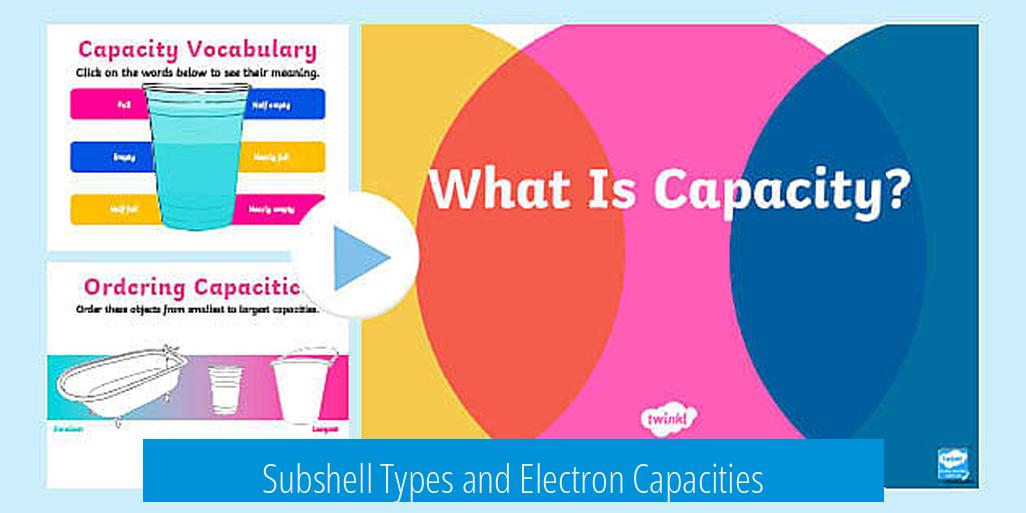Capacity of Electron Shells in Atoms

The capacity of electron shells in atoms depends on the types and numbers of subshell orbitals within each shell, with electrons filling these subshells according to specific energy rules rather than simply completing one shell before moving to the next.
Subshell Types and Electron Capacities

Electron shells consist of subshells labeled s, p, d, and f. Each subshell can hold a fixed number of electrons:
- s subshell: 2 electrons
- p subshell: 6 electrons
- d subshell: 10 electrons
- f subshell: 14 electrons
These numbers reflect the distinct shapes and orientations of the atomic orbitals contained within each subshell.

Shell and Subshell Structure
The first electron shell has only an s subshell (1s). The second shell contains both s and p subshells (2s, 2p), and so on. For example:
- 1st shell: 1s
- 2nd shell: 2s, 2p
- 3rd shell: 3s, 3p, 3d
- 4th shell: 4s, 4p, 4d, 4f
This layering forms the basis for electron configuration in atoms.
Electron Filling Order and Energy Considerations
Electrons fill subshells in order of increasing energy, not necessarily by completing one shell before starting the next. For instance, the 4s subshell fills before the 3d subshell because 4s has lower energy.
This leads to configurations such as:
| Shell/Subshell | Electrons Filled |
|---|---|
| 1st shell (1s) | 2 |
| 2nd shell (2s, 2p) | 8 |
| 3rd shell (3s, 3p, 3d) | 8 before 4s fills, then 10 in 3d after 4s fills |
| 4th shell (4s, 4p, 4d, 4f) | 2 electrons in 4s before 3d completes |
Thus, the third shell can hold more than the simple sum of 2+6+10 electrons if 4s fills first due to energy level variations.
Relation to Atomic Models and Stability Rules
While early models like Bohr’s suggested electrons fill shells in neat steps, the current Schrödinger model introduces atomic orbitals with distinct energy levels.
The octet rule, for instance, reflects a tendency for atoms to fill electron subshells to reach a stable configuration of eight valence electrons due to energy minimization.
Understanding shell capacity requires considering electron energies, subshell types, and filling sequences rather than simple shell counts.
Key Points
- Electron shells contain subshell orbitals: s, p, d, f with capacities of 2, 6, 10, 14 electrons.
- Shell capacity depends on available subshells; first shell has 1s, second has 2s and 2p, etc.
- Filling order follows energy levels, not strict shell completion—for example, 4s fills before 3d.
- Electron configurations arise from energy considerations governed by the Schrödinger model.
The Capacity of Electron Shells in Atoms: Unlocking Atomic Secrets One Electron at a Time
So, what’s the capacity of electron shells in atoms? It’s the number of electrons that each shell or energy level can hold around the nucleus. But, it’s not just about big numbers; it’s about how those electrons arrange themselves in neat layers and quirky little zones called subshells.
Before we dive in, imagine an atom as a multi-story apartment building. The shells are floors, and subshells are rooms of different sizes. Electrons are the tenants—each with a maximum space allowance. Now, does every floor have the same number of tenants? Nope. That’s where things get interesting.
Meet the Electron Team: Four Types of Subshell Orbitals
Electron shells contain smaller groups called subshells, with four main types: s, p, d, and f. Each subshell has a maximum number of electrons it can host. The rules go like this:
- s subshell: 2 electrons max
- p subshell: 6 electrons max
- d subshell: 10 electrons max
- f subshell: 14 electrons max
Think of these like rooms that come in different sizes. The s room fits just two tenants, p houses six, d room is larger with ten, and f has fourteen bedspaces. But why such a variety? The structure of an atom demands complexity.
The Apartment Floors: Shells and Their Subshells
Each shell—think of it as an energy level or floor—contains one or more types of these subshells. The first shell, which is closest to the nucleus, is simple. It has just one subshell: 1s. This means it can hold only 2 electrons at max.
Moving up, the second shell includes 2s and 2p subshells. The 2s holds 2 electrons, the 2p a maximum of 6, for a total of 8 electrons in the second shell. The third shell expands further with 3s, 3p, and 3d subshells. This pattern repeats in increasingly complex ways higher up.
It’s like floors getting more rooms, and the tenants filling them according to the room size and availability.
Electrons Don’t Just Fill Floors in Order—Here Comes the Plot Twist!
Now, you might assume that electrons fill the shells perfectly from one floor to the next in sequence—first floor full, then second, and so on. Not quite. Electrons are picky about energy. They want to settle into the lowest energy available, even if that means jumping ahead or nesting in spots on different floors.
For example, the 4s subshell actually has less energy than the 3d subshell. That means electrons first fill 4s with 2 electrons before the 3d subshell starts filling. This quirky behavior explains why the third shell can hold more than just 8 electrons.
So, the electron configuration for these shells can look like this:
- Shell 1: 2 electrons (1s only)
- Shell 2: 8 electrons (2s + 2p)
- Shell 3: 18 electrons (3s + 3p + 3d — after filling 4s)
- Shell 4: Starts with 2 electrons (4s)
This order explains why some atoms break the ‘filling in order’ intuition. It’s a subtle dance governed by quantum mechanics and energy levels rather than simple sequential stacking.
Digging Deeper: Beyond Bohr—The Quantum Model and Atomic Orbitals
Why all this fuss about where electrons go? Because the old Bohr model, the one you might have doodled in school, just isn’t accurate enough to predict chemical behavior or atomic capacity precisely.
Enter the Schrödinger model, with atomic orbital wave functions. Instead of neat planetary orbits, electrons behave more like fuzzy clouds around the nucleus, each cloud corresponding to a specific orbital in a subshell.
These orbitals have different shapes (spherical for s, dumbbell for p, and more complex for d and f), which impact how electrons pair and influence an atom’s properties.
If you’re curious, this also relates to the octet rule, a chemistry nugget that says atoms are most stable when their outer shell holds eight electrons. This explains why atoms bond and form molecules—they’re sharing or exchanging electrons to fill their outer shells and reach stability.
Why Should You Care About Electron Capacities?
Understanding electron shell capacity isn’t just academic nitpicking. It lays the foundation for chemistry, materials science, and even fields like electronics.
For example, the colors of transition metals (think copper, gold) arise because of electrons dancing between d orbitals. The magnetic properties of certain materials come from unpaired electrons in these shells. Even the conductivity of metals hinges on how electrons fill and jump between shells.
Next time you sparkle at a gold ring or wire a circuit, remember that the secret lies in how electrons arrange themselves in those tiny atomic apartments.
Want a Practical Tip? Use Electron Capacity to Predict Stability
If you’re tinkering with chemical reactions or curious why certain elements behave the way they do, check their electron configuration. Elements tend to reach stable arrangements with filled or half-filled subshells—making them less reactive or more eager to bond.
So instead of memorizing weird rules, think energy and capacity first. Think about the subshell sizes and energy priority. This mindset helps you predict elements’ behavior without cracking open a textbook every time.
In Summary
- Electron shells hold electrons in layers. Each shell contains subshells—s, p, d, and f—that vary in capacity.
- Capacities per subshell: s (2), p (6), d (10), f (14).
- Electrons fill subshells by energy, not just shell order. For example, 4s fills before 3d, complicating capacity counts.
- The Schrödinger model helps explain orbital shapes and filling patterns, superseding Bohr’s simplistic view.
- Electron arrangements govern chemical properties and stability, especially linked to the octet rule.
So, can you now picture those electron apartments? Understanding electron shell capacities means unlocking the rulebook atoms live by. And that’s where chemistry begins — in the tiniest shell spaces housing electrons just right.
What is the maximum number of electrons that each type of subshell can hold?
The s subshell holds 2 electrons, the p subshell holds 6, the d subshell holds 10, and the f subshell holds 14 electrons.
How are electron shells structured in terms of subshells?
Each shell contains one or more subshells. For example, the first shell has only the 1s subshell. The second shell contains both 2s and 2p subshells.
Why don’t electron shells fill up in a simple order from one shell to the next?
Electrons fill subshells based on their energy levels, not shell numbers. For example, the 4s subshell fills before the 3d because 4s has lower energy.
How does the filling order affect the total electrons in a shell?
The 4th shell can contain 2 electrons in the 4s subshell before the 3rd shell fills its 3d subshell with 10 electrons. This causes shell electron counts like 2, 8, 18, 2.
What role do atomic orbitals play in electron capacity?
Atomic orbitals define regions around the nucleus where electrons are found. Different orbital types have limits on how many electrons they can hold, affecting the atom’s electron structure.
How does the octet rule relate to electron shells and their capacity?
The octet rule suggests atoms are stable when their outer shell holds eight electrons. This influences how electrons fill shells and form bonds.





Leave a Comment